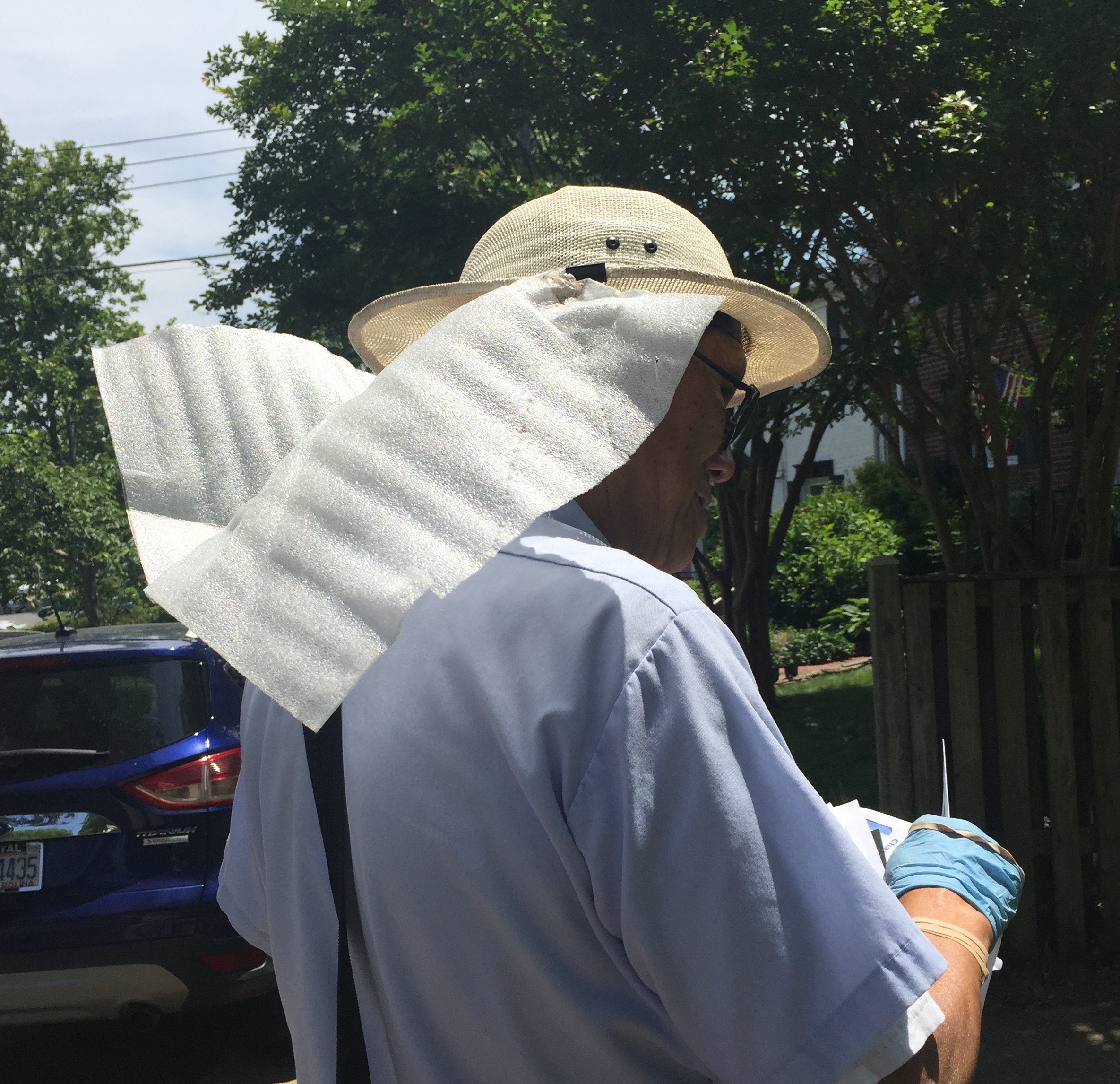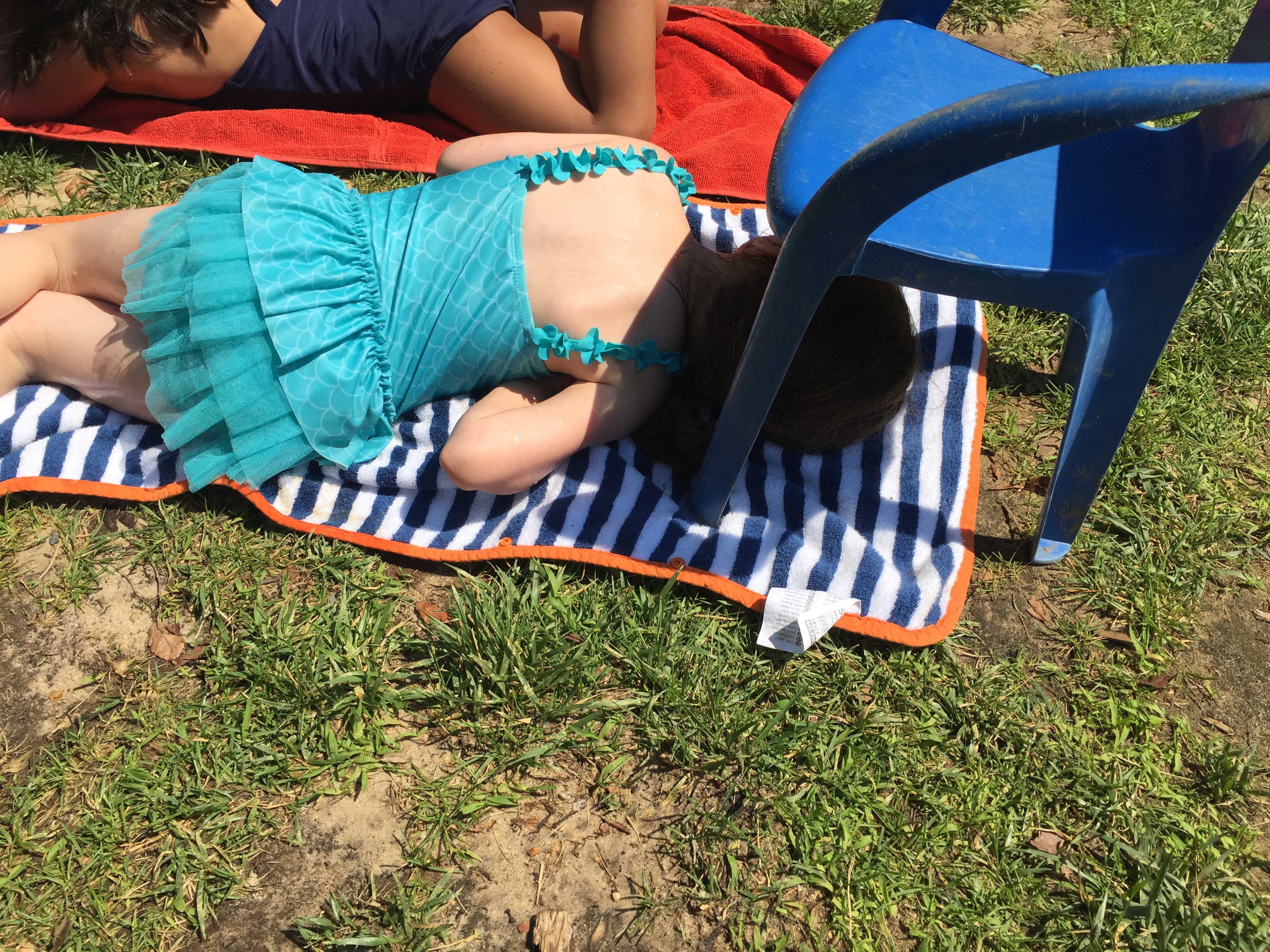How NSTA Expanded My Small Town World
By Kate Falk
Posted on 2019-06-11
Guest blog post by Pam Devers
I grew up as the typical “small town girl living in a small town world” (Journey). In the eighth grade my mind was set that I was going to be a science teacher and teach in my hometown. It took about a decade of working in a lab and jobs in even smaller schools to make it back to my town with a population of nine thousand. Contentment was mine at this point, but then I found out through NSTA that there was more than just the NE corner of the fly over state of Oklahoma.
For years I had gone to workshops locally, but then I heard about NSTA having a conference in San Diego. A fellow teacher and I asked our principal if we could go. We figured the least they could say was no, which would not have hurt us. Instead, we got a yes and did our little victory jig. The whole conference weekend kept my mind in overdrive from all the new ideas discussed and shown at the sessions. I was hooked, so of course we asked the next year and the next. Sometimes we got a quick yes, sometimes we heard others should be allowed an opportunity to attend in their fields but many never applied. For years we did our little dance and opened our world.
I have seen famous people speak telling about their insights. My claim to fame that I tell my students, is when I touched Bill Nye. Really, I was going up an escalator as I saw him making his way up the stairs beside my sloth way of maneuvering. I got off fast then walked swiftly to tap him on the shoulder to get his attention. He turned around, politely listened to my rambling introduction and admirations then we parted. My students know me well enough, so I tell the true story as they grin and roll their eyes at me.
I emulate demonstrations and lessons learned from teachers around the country. They also explained the success and failures to avoid they experienced. Exhibit booths of equipment beckon to be in my classroom. During the conference, I make a list to write grants for more TOYS (T.angible O.bjects Y.ielding S.cience). The main downfall to this is when I have to pack all my collected toy boxes to get my room ready to paint for the summer.
The conferences have taken me to major cities within our nation, which I would not have seen otherwise. NSTA also has shown me other opportunities to learn more from others outside of conferences. I was truly blessed with a trip of a lifetime to Japan for the TOMODACHI STEM Leadership Conference with amazing teachers and students. I just saw on Facebook one of our students won the Toshiba ExploraVision competition which thrills me. This year, I applied and get to go to Canada for the EINSTIENPLUS workshop which I am super excited about attending. I would not have known about it if I did not get NSTA’s publication listing it as an available resource for teachers.
I was fifty when I went to Japan and started filling out applications of opportunities outside of my little world. I have been told no a few times, pouted a little, but then filled out more applications. My classroom career has a few more years left. If I had things to do over, I would have looked out into the big picture sooner but I will always be thankful for my membership with NSTA.

Pam Devers teaches Chemistry I, Honors Chemistry II, Honors Physics, and Teach Oklahoma at Pryor High School in Pryor, Oklahoma. This year marks Devers’ 30th year of teaching.
Guest blog post by Pam Devers
I grew up as the typical “small town girl living in a small town world” (Journey). In the eighth grade my mind was set that I was going to be a science teacher and teach in my hometown. It took about a decade of working in a lab and jobs in even smaller schools to make it back to my town with a population of nine thousand. Contentment was mine at this point, but then I found out through NSTA that there was more than just the NE corner of the fly over state of Oklahoma.
Experience STEM by the Bay This Summer With NSTA
By Carole Hayward
Posted on 2019-06-11
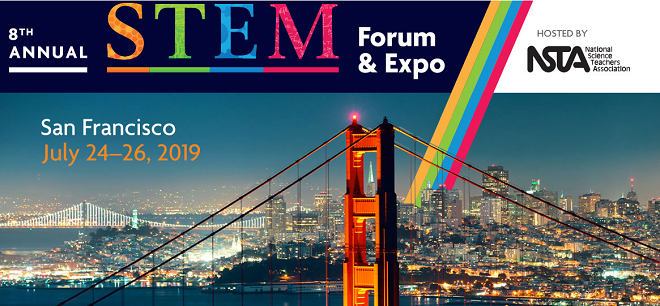
Guest blog post by Jeffrey LeGrand Douglass
The exhibit hall at the 8th Annual STEM Forum & Expo, hosted by NSTA, is gonna be so LIT that even the rolling fog of San Francisco won’t be able to hide the excitement and experiences that await all who are attending! Enjoy the beauty of the City by the Bay while benefiting from the enrichment of attending the NSTA STEM Forum & Expo. Our exhibit hall is truly not to be missed, and with over 70 amazing companies already on board to exhibit, there will definitely be something for everyone to see and do.
NSTA will kick off exhibit hall activities Wednesday night with a two-hour exclusive preview reception from 4:30 to 6:30pm. Enjoy eating and drinking while exploring the hall, networking with fellow educators, and mingling with exhibitors followed on Thursday and Friday by two additional days of fun activities and engagement.
A special shout out to STEMScopes for sponsoring this year’s attendee bags. Bags can be picked up with your registration materials, and be sure to stop by their booth to thank them for their generosity and support. Use your bag to hold all of the amazing swag you are sure to collect from our participating exhibitors.
So what can you expect to see on our exhibit hall floor? Check out just some of the highlights from a small group of our current exhibitors.
- Learn about ODYSSEY, the unique instruction program for general chemistry from Wavefunction.
- Let 3Doodler show you how you can reach learners who have trouble grasping abstract concepts with their 3D printing pens.
- Carolina Biological can help you prepare your students for STEM careers with their STEM products.
- Lodestone is offering FREE resources for the K-12 educational community that include topics for math, physics, and chemistry, to name a few.
- If you like robots, then go see Kinderlab Robotics to find out about KIBO, a screen-free robot kit that lets 4–7 year olds build, code, and run their own robots.
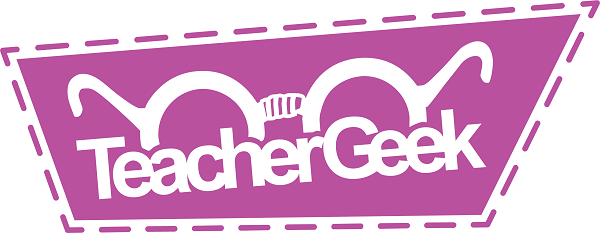
Just in case that wasn’t reason enough to make sure that you don’t skip the exhibit hall this year, NSTA is very excited to announce that TeacherGeek will be sponsoring a brand new engaging makerspace area for all attendees right on the exhibit hall floor. According to Darren Coon, CEO of TeacherGeek:
“Zip, Bang, Grab, Woo-hoo!!! These are the sounds you will hear coming from the TeacherGeek Maker Space area at the STEM Forum & Expo. Are you up for the challenge? Compete against other attendees for fun prizes: creating racecars, breaking bridges, performing undersea tasks.”
These and many other wonderful companies will be on the exhibit floor; they all want to meet you, talk with you, and demonstrate to you that they share your devotion to STEM education and are there to help you succeed in preparing the next generation of learners.
New exhibitors are signing up every day, and you won’t want to miss one second of the fun that is sure to take place. Make sure you register to attend the 8th Annual STEM Forum and Expo, hosted by NSTA, July 24–26, 2019, at Moscone Center West in beautiful downtown San Francisco.
Tony Bennett may have left his heart in San Francisco, but what you will be taking with you from San Francisco will leave an impression on you for years to come.

Guest blog post by Jeffrey LeGrand Douglass
Ed News Roundup: Women Engineers You Should Know
By Cindy Workosky
Posted on 2019-06-10

In this week’s Education News Roundup, USA Today takes a look at salaries and housing costs for teachers; Education Week examines how to make teacher leadership roles more effective; some women engineers you should know, and more.
Women Engineers You Should Know
There are many women engineers whose lives, careers, and achievements might go unnoticed – yet each has a compelling, dynamic, and thought-provoking story. To celebrate their contributions and lives, SWE Magazine reached out on SWE’s social media channels, asking “Who are the women engineers we should know?” Read the story featured in SWE Magazine.
Charters were supposed to save public education. Why are Americans turning against them?
The vanguard of this unrest is organized teachers, political progressives and public education activists. Yet public opinion, even if it is moving more slowly, is tilting in the same direction. According to the school-choice-favoring EdNext Poll, support for charters slipped noticeably in 2017. Though it rebounded a bit in 2018, it did so mainly among Republicans, with “only 36 percent of Democrats now supporting their formation” — a phenomenon likely due to the polarizing influence of Education Secretary Betsy DeVos. The most recent polling on charters in Los Angeles County found that 75 percent of residents favor “improving the existing public schools” over pursuing “additional charter school options.” Read the story featured in The Washington Post.
Science News: Increase in Education Specialists In University Science Departments
Science professors go through years of training to learn about their field, yet they often don’t receive any formal education in how to teach students about it. A new study takes a decade-long look at one way that science departments in the California State University (CSU) system are trying to amend that by bringing faculty with educational expertise into the fold. Read the story featured in Science Daily.
Can’t pay Their Bills With Love–In Many Teaching Jobs, Teachers’ Salaries Can’t Cover Rent
New teachers can’t afford the median rent almost anywhere in the U.S, the analysis shows. But that’s not the full story. Despite widespread demand for higher salaries, teachers in some regions are actually making ends meet, especially as they approach the middle of their careers. In other areas, mid-career teachers are right to say they can’t afford to live on their salaries without picking up side hustles or commuting long distances. Some of those places are only affordable for the very highest-paid teachers. And then there are places that no teacher can afford, no matter how much they earn. Read the story featured in USA Today.
How Can States and Districts Make Teacher-Leadership Roles More Effective?
This form of professional learning—in which an accomplished teacher is given instructional leadership responsibilities while still remaining in the classroom—has become popular in many places, but there is a lack of explicit guidance on how to build this capacity. Read the story featured in Education Week.
Limiting Science Education: Limiting Ourselves
We’ve landed men on the moon, mapped out our genomes, and split atoms, but for the past 20 years, nobody knew why two grapes produced plasma in a microwave. Energy is conserved. Carbon’s atomic number is six. The mitochondria is the powerhouse of the cell … Throughout my entire high school career, I’ve heard all of these facts presented to me, but never once have I felt as intrigued as I have from this bizarre phenomenon. Welcome to the world of high school science education. This essay, by James Chan, age 17, is one of the Top 12 winners of the New York Times Sixth Annual Student Editorial Contest. Read the story featured in The New York Times.
New Science Standards Approved For Utah Students after Five Hours of Debate
The Utah State School Board approved new science standards last week, the first updates in science standards in high school biology, chemistry and physics since 2002, and in Earth science since 2012. It is also the first update of science standards for kindergarten through second grade since 2010. Read the story featured on KSL TV website.
Stay tuned for next week’s top education news stories.
The Communication, Legislative & Public Affairs (CLPA) team strives to keep NSTA members, teachers, science education leaders, and the general public informed about NSTA programs, products, and services and key science education issues and legislation. In the association’s role as the national voice for science education, its CLPA team actively promotes NSTA’s positions on science education issues and communicates key NSTA messages to essential audiences.

In this week’s Education News Roundup, USA Today takes a look at salaries and housing costs for teachers; Education Week examines how to make teacher leadership roles more effective; some women engineers you should know, and more.
Rock On!
By Gabe Kraljevic
Posted on 2019-06-08
 I am planning to teach a lesson on rocks with a third grade class in the fall, but I am unaware as of where to find inexpensive rock/mineral kits. How did you teach the lesson in a way that engaged the students?
I am planning to teach a lesson on rocks with a third grade class in the fall, but I am unaware as of where to find inexpensive rock/mineral kits. How did you teach the lesson in a way that engaged the students?
– A., Pennsylvania
Studying rocks is such a great, hands-on unit and is a natural subject for kids to immerse themselves into!
In almost every state and province there are mineral and mining organizations and government agencies that have kits/resources available. Do a quick search in your region to find where you can order inexpensive sample kits.
A few good resource sites:
• American Geosciences Institute: A huge repository of educational resource links
• Mineralogical Society of America
• Mining Matters (Canada)
Once you get some kits students can go through several of the properties: hardness, streak (use the back of sample subway tiles), lustre, color, maybe even fluorescence (you can use inexpensive “black light” pens but make sure to review safety procedures).
It is easy to combine other subjects into this topic! Resource maps identifying the locations of significant mineral deposits in your region not only bridge to social studies but can lead to discussions on where communities arose, conservation issues, pros and cons of mining, and so on. Finding out where we use solid minerals in our homes and consumer products connects what students are learning to their everyday lives. Research projects and presentations on specific minerals are great language arts activities. Incorporate engineering practices by designing mines that have the least environmental impact.
Hope this helps!
 I am planning to teach a lesson on rocks with a third grade class in the fall, but I am unaware as of where to find inexpensive rock/mineral kits. How did you teach the lesson in a way that engaged the students?
I am planning to teach a lesson on rocks with a third grade class in the fall, but I am unaware as of where to find inexpensive rock/mineral kits. How did you teach the lesson in a way that engaged the students?
– A., Pennsylvania
Studying rocks is such a great, hands-on unit and is a natural subject for kids to immerse themselves into!
Robert E. Yager Exemplary Teaching Award—2019 winners
By NSTA Web Director
Posted on 2019-06-04
The Robert E. Yager Exemplary Teaching Award recognizes six full-time K–12 teachers of science who successfully use innovation and excellence in their classroom.
District III

Katherine Owens
STEM Teacher
Washington Episcopal School
Bethesda, Maryland
After almost a decade in the consumer product industry as the Vice President of Business Development, Katherine Owens felt a calling to give back to others and to become a teacher. She wanted to join the growing movement of educators interested in exploring and developing new approaches and weaving innovation into the classroom. At her first teaching position Owens developed and taught an in-school pilot STEM program. The class was a great success, and she has been teaching the expanded program to grades 1–5 ever since. This program takes an interdisciplinary approach to exploring STEM concepts, their application, and STEM’s relation to invention; invention STEM challenges; and the role of STEM in business and global, social and environmental responsibility. Owens firmly believes that collaboration, creativity, and innovative thinking in STEM education will greatly benefit students for their future success. It is her mission as a STEM educator to promote excellence and innovation in science teaching to as many people as she can touch through her passion and wonderment of science. Nate Dennison, Elementary Grades Director at Washington Episcopal School, says, “It is once in a lifetime to have the privilege of working with and learning alongside a modern day renaissance woman such as Katherine Owens. … Katherine is someone who sees the big picture of schooling and understands the relationship of thinking and learning, questioning and innovating.”
View Katherine Owens’s PowerPoint presentation
District V
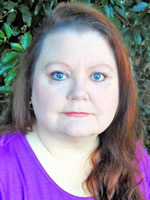
Virginia Hall
Science Teacher
Mary G. Montgomery High School
Mobile, Alabama
Virginia Hall immerses her classes in inquiry-based learning (IBL), which encompasses a variety of teaching and learning approaches. She passionately believes that science belongs to all students and actively demonstrates that students with a wide range of diversity and a host of abilities can learn science. Hall takes complicated science topics and designs lessons that enables all learners to gain an understanding of the topic. Furthermore, she encourages students to engage in argument based on evidence, as well as construct explanations and design solutions. Preparing students to use these as well as other vital skills outside the classroom is especially important to her. Students are only in the traditional classroom a short period, so she wants to develop a lifelong learner. Hall is also a NASA teacher leader who has developed lessons to incorporate NASA into the average classroom. She has presented at several conferences in the last year. Stephanie C. LeGrone K–12 Science Supervisor Mobile County Public Schools, says, “I have had the honor to see Mrs. Hall grow and really become my go-to teacher for all things Earth science. She has a passion for science that is unparalleled and has dedicated herself to bettering herself and her craft. … She embodies science and STEM in everything she does and often works tirelessly to ensure her lessons have literacy, numeracy, and data analysis components while still digging deep into the standards.”
View Virginia Hall’s PowerPoint presentation
District IX
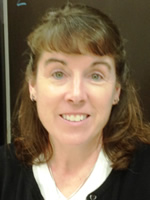
Cathy Oates-Bockenstedt
Science Teacher
Eden Prairie’s Central Middle School
Eden Prairie, Minnesota
Cathy Oates-Bockenstedt is fortunate to have had outstanding opportunities for contributions. For 30 years, she has continued the lessons she learned from Dr. Bob Yager back in 1988, when he encouraged the combination of science with technology and society. Students are the main beneficiaries of this dedication. She became an author of two books designed to help preservice teachers get off to a good start in Earth science teaching. Oates-Bockenstedt spent 10 years volunteering on a Foundation Board of Directors, helping to support and enhance excellence in classrooms, through generous grants and student scholarships, throughout her school district. She achieved National Board for Professional Teaching Standards Certification for Early Adolescent Science in 2004. This certified that she was heading toward excellence in what she knows and is able to do as a teacher. Through it all she has a foolproof system to help keep her motivations high in this amazing career that can be quite challenging. Timothy M. Cooney, University of Northern Iowa Professor Emeritus Earth Science and Science Education, shares, “I have known Cathy for about 37 years. … I strongly believe that you would struggle to find a science teacher more deserving and more qualified than Cathy. [She has] outstanding abilities to motivate and challenge students and in addition, her abilities to motivate and challenge her fellow teachers.”
View Cathy Oates-Bockenstedt’s PowerPoint presentation
District XI

Jennifer Jones
Science Teacher
Ogallala High School
Ogallala, Nebraska
Jennifer Jones’s main philosophy on science teaching is that “science is a verb.” Her students often joke that they “science” through things because they are doing, not just absorbing information. Phenomena-based learning, hands-on learning, application of ideas to the real world, three-dimensional learning, and building science confidence are all important in her teaching process. Jones has adopted phenomena-based storylines as an important anchor in her lesson design, starting each unit with a specific case or instance that students can all observe and experience. She follows the “ABC” rule in her classroom, “activity before content.” Over the past decade, she has made significant contributions to her students, community, and state in the science education field. Jones was an active advocate for science education early in her career and has created a culture of collaboration and sharing among educators. One of her main passions is to ensure that rural students have the same opportunities as those in urban areas. Raelyn DeVries, former student and mentee of Jennifer Jones, says, “She has the ability to understand and meet the needs and learning abilities of those in her classroom while not inhibiting the education of others. She makes it very difficult to have the mentality of ‘Memorize-Regurgitate-Forget’ and instead facilitates learning of overarching concepts and drawing connections between ideas.”
The Robert E. Yager Exemplary Teaching Award recognizes six full-time K–12 teachers of science who successfully use innovation and excellence in their classroom.
Working with a dream team, learning about engineering habits of mind
By Peggy Ashbrook
Posted on 2019-06-02
Taking a chance, I asked two colleagues if they would work with me on a webinar about supporting young children’s early engineering problem-solving. They each said “Yes!” and in the process I have been learning much from Carrie Lynne Draper, MEd, and Beth Van Meeteren, PhD. In the webinar we’ll discuss helping children learn to use materials and their surroundings to build and solve problems as part of early childhood education. The children’s engineering we’ve observed included seeking to build a stable tower, using a stick as a tool, and planning a process to take turns.
Adults and children design solutions to everyday problems such as feeling too hot from being in direct sunlight. Engineering Design K-2-ETS1-1, a “by the end of grade 2” performance expectation in the Next Generation Science Standards, states that children should, “Ask questions, make observations, and gather information about a situation people want to change to define a simple problem that can be solved through the development of a new or improved object or tool.”
While designing sunshades adults and children both may “Plan and conduct investigations to determine the effect of placing objects made with different materials in the path of a beam of light” (NGSS 1-PS4-3) and “Analyze data obtained from testing different materials to determine which materials have the properties that are best suited for an intended purpose” (NGSS 2-PS1-2).
I hope you’ll join us for the live webinar through Early Childhood Investigations, “Supporting Young Children’s Creative Thinking Using Problems They Care About: Engineering Design In ECE,” on Wednesday June 5, 2 PM Eastern time, or view the archived version.
Asking questions and sharing your experiences develops the early childhood education community’s ability to support children’s learning so I look forward to hearing from you!
Taking a chance, I asked two colleagues if they would work with me on a webinar about supporting young children’s early engineering problem-solving. They each said “Yes!” and in the process I have been learning much from Carrie Lynne Draper, MEd, and Beth Van Meeteren, PhD. In the webinar we’ll discuss helping children learn to use materials and their surroundings to build and solve problems as part of early childhood education. The children’s engineering we’ve observed included seeking to build a stable tower, using a stick as a tool, and planning a process to take turns.
Circle of Life 2.0
By Gabe Kraljevic
Posted on 2019-05-31
 I am student teaching in a first grade classroom and we are going to start covering life cycles. What are some good ideas I can do in my engage section?
I am student teaching in a first grade classroom and we are going to start covering life cycles. What are some good ideas I can do in my engage section?
— G., Oklahoma
I just answered a similar question about teaching plant life cycles to Kindergarten students. Please refer to Circle of Life 1.0 . I will continue that article here by addressing animal life cycles in early years.
Animal reproduction takes more time than you may have during your practicum. However, there are a few hands-on activities that you may want to use. Obtain some mealworms from a pet store and ask if they can include some pupae and adults. (They might donate them if you tell them it’s for elementary students!) House these in lidless, clear plastic food containers with oatmeal. Mealworms are the grubs (larvae) of darkling beetles and they follow a life cycle like butterflies. Eggs of these beetles are almost impossible to find, but you can ask the students to conjecture how the larvae came about. Students can observe and journal the different life stages. Use magnifiers for real close ups!
If you have a budget and time, consider butterflies (purchased from science suppliers) or lady beetle larvae (available from some garden centers).
I don’t recommend raising mantids – they follow an incomplete metamorphosis cycle (no distinct change between young and adults and no pupal stage). They are predators and extremely cannibalistic. Stick insects also follow incomplete metamorphosis and may not be allowed in all regions, but their eggs are easy to find and they are very easy to feed.
Hope this helps!
 I am student teaching in a first grade classroom and we are going to start covering life cycles. What are some good ideas I can do in my engage section?
I am student teaching in a first grade classroom and we are going to start covering life cycles. What are some good ideas I can do in my engage section?
— G., Oklahoma
Radioactivity outlines a journey that will steer your students toward authentic problem solving while grounding them in integrated STEM disciplines. As are the other volumes in the series, this book is designed to meet the growing need to infuse real-world learning into K–12 classrooms.
Radioactivity outlines a journey that will steer your students toward authentic problem solving while grounding them in integrated STEM disciplines. As are the other volumes in the series, this book is designed to meet the growing need to infuse real-world learning into K–12 classrooms.
Ed News: How Can We Get More Highly Effective Teachers to Serve as Mentors?
By Kate Falk
Posted on 2019-05-30

This week in education news, state school board committee approved new science standards for Utah public school students; states are beginning to integrate CTE and STEM-related courses into high school graduation requirements; despite evidence suggesting that high-quality instructional materials increase student new science curriculum; researchers argue that policymakers should be willing to invest roughly 15 times more to encourage effective teachers to become mentors; and Harvard economist says we’re losing Einsteins every day.
Proposed Science Standards Head to State School Board
A State School Board committee approved new science standards for Utah public school students in grades K through five and nine through 12, but not before some pushback on the teaching of evolution and climate change. Except for some slight tweaks, the proposed standards were approved by the Standards and Assessment Committee and will be considered for adoption at an upcoming State School Board meeting. Read the article featured in the Deseret News.
Diploma Requirements Still Out of Step with Higher Ed Eligibility in Most States
States are beginning to integrate career and technical education (CTE) and STEM-related courses into high school graduation requirements, and some are also revising diploma pathways to link coursework to postsecondary goals, but the updates fall short of ensuring credits earned make students eligible for admission to colleges and universities, according to a new paper from the Center for American Progress (CAP). Read the article featured in Education DIVE.
How Districts Can Improve Learning Through High-Quality Curriculum
States and districts have been slow to implement high-quality instructional materials and the training to use them, despite evidence of the positive impact on learning outcomes. Read the article featured in District Administration.
Seattle School Board Approves Controversial Science Curriculum
After intense public scrutiny, the Seattle School Board approved the district’s recommended science curricula for the city’s elementary- and middle-school students. The vendor, Amplify Science, came under suspicion over the past month because of the way it was introduced to the district: through a waiver process that included donated or discounted materials from the company, and not a formal districtwide vetting process. Read the article featured in the Seattle Times.
Bus Stops May Be as Good a Place as Any for a STEM Lesson
Be it for school or just running errands, thousands of children and their parents wait for the bus every day. A pilot program in Pennsylvania is trying to squeeze a little more science, technology, engineering, and math learning into those waits. Read the article featured in Education Week.
How Can We Get More Highly Effective Teachers to Serve as Mentors?
Relatively few highly effective teachers take on roles as mentors to student-teachers, researchers say. One solution? Pay them more—a lot more. Read the article featured in Education Week.
There’s A Nationwide STEM Teacher Shortage. Will It Cost Us The Next Einstein?
It’s striking to think about what our world would be missing if it weren’t for Albert Einstein: lasers, GPS, barcodes, to say nothing of our understanding of black holes, time/space, and the relationship between energy and matter. But what if a little boy named Albie E. never became the man known to history as Professor Albert Einstein? Read the article featured in Forbes.
Stay tuned for next week’s top education news stories.
The Communication, Legislative & Public Affairs (CLPA) team strives to keep NSTA members, teachers, science education leaders, and the general public informed about NSTA programs, products, and services and key science education issues and legislation. In the association’s role as the national voice for science education, its CLPA team actively promotes NSTA’s positions on science education issues and communicates key NSTA messages to essential audiences.
The mission of NSTA is to promote excellence and innovation in science teaching and learning for all.
Follow NSTA

This week in education news, state school board committee approved new science standards for Utah public school students; states are beginning to integrate CTE and STEM-related courses into high school graduation requirements; despite evidence suggesting that high-quality instructional materials increase student new science curriculum; researchers argue that policymakers should be willing to invest roughly 15 times more to encourage
Get a KLEW(S)! Collaboration is Key for Translating Contemporary Research into Teaching, Learning Science
Posted on 2019-05-28
I first encountered the KLEWS teaching strategy in an article in Science and Children (NSTA 2015), “KLEWS to Explanation-Building in Science.” I shared the article and modeled the strategy with teachers who wanted to support their K–5 students in the science practice of constructing explanations. I really liked the KLEWS chart. About a month ago, I had the opportunity to collaborate with other educators (read as: I needed help) while developing a first-grade lesson about sound. I discovered how KLEWS charts honor students’ ideas about phenomena, support students in developing explanations and models, and help teachers and students connect today with yesterday, and decide where to go next (coherence). Now I L-O-V-E the K-L-E-W-S chart!
The KLEWS chart is a revamped version of the KWL chart (What do we know? What do we wonder? What did we learn?) for science. Columns were added for evidence and science ideas and words (Hershberger and Zembal-Saul 2015).
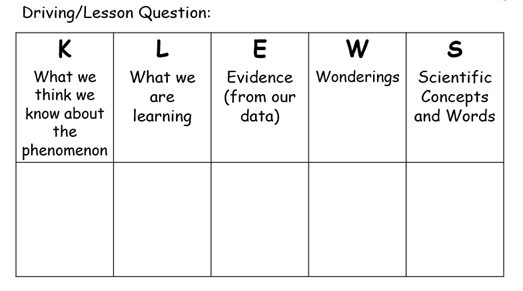
But I’ll return to the KLEWS chart in a minute.
The Sound Lesson:
I wanted to create an opportunity for students to make sense of the DCI element PS3.A: Sound can make matter vibrate, and vibrating matter can make soundand use the element of the CCC Cause and Effect Events have causes that generate observable patterns as a lens to help students organize their thinking. The phenomenon I chose (and was really excited about) focused on Evelyn Glennie, a deaf percussionist who hears with her feet. In a clip from Sesame Street, Glennie removes her shoes as she prepares to audition for Oscar the Grouch’s band. She tells a confused Oscar that this helps her hear the music.
I wanted to ask the first-grade students to draw a model to explain how someone can hear with their feet (SEP element: Developing and Using Models Develop a model to represent relationships in the natural world) but I wasn’t sure they could. Maybe they could draw the model with some scaffolding, but I wondered how much would be needed.
I reached out to my friend Beth Pesnell for help. Beth is a former elementary school teacher and K–8 math and science curriculum specialist (she is currently pursuing a Ph.D.). She assured me first-grade students could draw a model. “Give them a blank piece of paper!” she said excitedly.
Beth also knew I wanted to give students the opportunity to revise models at different points in the multi-day lesson and asked if I had considered using a KLEWS chart. She listened to my ideas about the lesson and together we made the following plan (details are limited due to space constraints).
Kate and Beth’s Plan
- Post the KLEWS chart in the room.
- Read The Listening Walk to the class. (This book does not steal students’ “ahas” about how we hear or how sounds are made.) The book ends by asking, “How many different sounds can you hear right now? Close your book and count them!”
- Ask students, “What do you think we know about how we hear?” Record their responses under K.
- Introduce the phenomenon (Evelyn Glennie playing drums with Oscar the Grouch); ask students to share their thinking with a partner.
- Ask students to draw (individually) a model to explain how Evelyn Glennie hears with her feet.
- Tell students to put their models away (or collect them) (don’t ask them to share yet).
- Give students the opportunity to explore sound at different stations around the room.
- Say to students “You probably have some new ideas about sound and how we hear. What would you like to change or add to your model?” Give students time to revise their models.
- Ask students to join their predetermined groups and share what they changed or added to their model, and explain why.
- Ask students to share with the class what they heard other students say they added to their model and why. Record their responses in the L column. (I was intentional about where each response was recorded – keeping them next to/in line with related “things we think we know” in the K column.)
- Each time a response is recorded in the L column, ask students for evidence to support the learning. Record the evidence under E, keeping it next to/in line with to the L response it supports.
- In the S column, record the big science ideas students may have verbalized or described in their learning statements. Concepts are recorded in the S column throughout the lesson, when students connect the ideas with their learnings (L column).
- As new “wonderings” are expressed, record them in the W column. (Again, I was intentional where I recorded their questions in this column.)
- This learning experience and model will help inform the engineering design found in 1-PS4-4.
Wow! I was excited to teach the lesson, but also a bit nervous because I hadn’t used the KLEWS chart like this before. I was unfamiliar with the intentionality of where ideas are recorded in the columns, the fluidity between columns, and the navigation back and forth between the chart and student models as the lesson progressed. I wondered if I could find a video to help me visualize how to use the KLEWS chart (spoiler alert: I did).
I found a Teaching Channel blog post titled KLEWS: Supporting Claims, Evidence and Reasoning. The blog instructs educators on how to begin using the KLEWS chart in their classrooms by inviting us to watch third-grade teacher Maria Katsanos and her students using the KLEWS chart for the first time in the classroom. In a series of videos, we see Katsanos use the KLEWS chart to plan her lesson, support student sense-making, and reflect on how it required her to change the way she thought about teaching science. (Thanks to Katsanos for bravely trying something new with an audience for the benefit of other educators and their students.)
As I watched Katsanos and her students, I made notes on my lesson: What should I listen for in students’ conversations? What questions could I ask to get students thinking about their evidence? Which anticipated student “learnings” might lead to concepts/words to record in the S column? I suddenly realized I was collaborating with Maria Katsanos like I had with my friend, Beth Pesnell.
Now I was really excited to teach this lesson.
Before teaching this lesson in the classroom, I planned to use it as an immersion experience for elementary teachers who were new to three-dimensional teaching and learning in service to phenomena. On the morning of the workshop, a teacher expressed concern that she didn’t teach science every day and didn’t know how to help students connect their sense-making from one class period to the next. It was a great question! And when the answer occurred to me, I smiled. Let’s just say I helped her and her colleagues get a KLEWS.
Do you want to collaborate on a KLEWS lesson? Whether you have questions that need answering or expertise to share, join the conversation by commenting below.
Resources:
More about Evelyn Glennie (children’s book)
Millman, I. 1998 Moses goes to a concert. New York: Farrar, Straus and Giroux.
More About KLEWS Charts
Zembal-Saul, C., K. L. McNeill, and K. Hershberger. 2013. What’s your evidence? Engaging K–5 students in constructing explanations in science. Pearson.
Hershberger, K , and C. Zembal-Saul. 2015. Methods and strategies: KLEWS to explanation-building in science. Science and Children 52 (6): 66–71.

Kate Soriano has more than 20 years of experience teaching K–12 students science in both formal and informal educational settings. Currently, she is supporting teachers in their transition toward the Next Generation Science Standards. Soriano is an NSTA NGSS Professional Learning Facilitator and Instructional Coach. She also serves on the EQuIP Peer Review Panel for Science. She holds a BS in geology and geophysics from Boston College, an MS in geology from the University of Wisconsin–Madison, and an MA in education from Humboldt State University.
Note: This article is featured in the May issue of Next Gen Navigator, a monthly e-newsletter from NSTA delivering information, insights, resources, and professional learning opportunities for science educators by science educators on the Next Generation Science Standards and three-dimensional instruction. Click here to sign up to receive the Navigator every month.
Visit NSTA’s NGSS@NSTA Hub for hundreds of vetted classroom resources, professional learning opportunities, publications, ebooks and more; connect with your teacher colleagues on the NGSS listservs (members can sign up here); and join us for discussions around NGSS at an upcoming conference.
The mission of NSTA is to promote excellence and innovation in science teaching and learning for all.
Future NSTA Conferences
2019 National Conference
STEM Forum & Expo
2019 Fall Conferences
I first encountered the KLEWS teaching strategy in an article in Science and Children (NSTA 2015), “KLEWS to Explanation-Building in Science.” I shared the article and modeled the strategy with teachers who wanted to support their K–5 students in the science practice of constructing explanations. I really liked the KLEWS chart. About a month ago, I had the opportunity to collaborate with other educators (read as: I needed help) while developing a first-grade lesson about sound.



